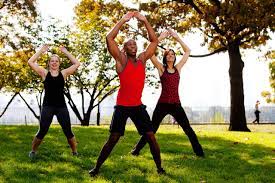Exercise is a fantastic way to boost your mood and stay in shape. Whether you’re a seasoned athlete or just starting on your fitness journey, you probably already know that a good workout involves more than just the main activity. Warm-up and cool-down exercises are essential components of any fitness routine as they play a crucial role in preventing injuries and maximizing the benefits of your workout.
Explore how warm-up and cool-down exercises can transform your routine and why they should never be overlooked.
The Basics of Warm-Up Exercises
A warm-up is a short session of light aerobic activities and stretching that precedes your main workout. Its primary purpose is to prepare your body for more intense physical activity by gradually increasing your heart rate and muscle temperature. Here’s why warm-up exercises are crucial.
Injury Prevention
When you jump into intense exercise without a proper warm-up, your muscles and joints are cold and less flexible, making you more susceptible to strains, sprains, and other injuries. A good warm-up gradually increases blood flow to your muscles, improving their elasticity and reducing the risk of injury.
Improved Performance
A well-executed warm-up helps enhance your physical performance during the main workout. It primes your body to handle higher-intensity exercises, allowing you to train more effectively and achieve better results.
Mental Preparation
Warm-up exercises also provide an opportunity to mentally prepare for your workout. As you focus on your breathing and body movements, you can shift your mind away from daily stressors and into the present moment, setting a positive tone for your exercise session.
What Makes a Good Warm-Up?
A proper warm-up typically consists of two main components:
- Aerobic Activity: This phase involves low-intensity aerobic exercises that get your heart rate up and increase blood flow to your muscles. Examples include brisk walking, light jogging, or cycling at a moderate pace. Aim for 5-10 minutes of aerobic activity.
- Dynamic Stretching: After your aerobic warm-up, it’s essential to perform dynamic stretching exercises. Dynamic stretches involve controlled movements that gently take your joints and muscles through their full range of motion. Leg swings, arm circles, and hip rotations are excellent examples. Spend 5-10 minutes on dynamic stretching.
The Significance of Cool-Down Exercises
Now that we’ve discussed the importance of warming up, let’s turn our attention to cool-down exercises. A cool-down is a set of light exercises and stretches that you do after your main workout. It serves several essential purposes, from recovery to injury prevention.
Gradual Recovery
After an intense workout, your heart rate and breathing remain elevated, and your muscles may be tight and fatigued. Cool-down exercises help your body gradually transition to a state of rest, allowing for a more comfortable recovery.
Muscle Relaxation
Cool-down exercises also promote muscle relaxation and reduce muscle soreness. They help prevent the buildup of lactic acid, which can contribute to post-workout stiffness.
Injury Prevention
Cooling down can help reduce the risk of injury. Abruptly stopping intense exercise can cause blood to pool in your extremities, potentially leading to dizziness or fainting. A proper cool-down prevents this by gradually slowing your heart rate and aiding in the removal of waste products from your muscles.
What Makes a Good Cool-Down?
A comprehensive cool-down should include the following elements:
- Low-Intensity Aerobic Activity: Similar to the warm-up, include 5-10 minutes of low-intensity aerobic activity, such as walking or slow cycling, in your cool down. This helps your heart rate gradually return to its resting state.
- Static Stretching: After your aerobic cool-down, perform static stretching exercises. These stretches involve holding a position to gently lengthen and relax your muscles. Focus on major muscle groups, holding each stretch for 15-30 seconds without bouncing.
Incorporating a Health-Friendly Lifestyle
To further support your fitness journey, it’s essential to adopt a health-friendly lifestyle. This includes maintaining a balanced diet, staying hydrated, managing stress, and getting adequate sleep.
- Nutrition: A nutritious diet provides your body with the essential nutrients it needs to function optimally. While supplements like multivitamins can play a supportive role in filling nutrient gaps, they should complement a well-rounded diet, not replace it. A health-friendly approach focuses on making smart dietary choices to gain nutrients from whole foods.
- Hydration: Staying hydrated is crucial for overall health and exercise performance. Aim to drink enough water throughout the day to maintain proper fluid balance. Water supports digestion, circulation, temperature regulation, and the transport of nutrients to cells.
- Stress Management: Prolonged stress can negatively impact your physical and mental health. Engage in stress-reduction techniques such as meditation, deep breathing exercises, yoga, or spending time in nature to help manage stress effectively.
- Sleep: Quality sleep is essential for muscle recovery and cognitive function. Aim for 7-9 hours of restful sleep each night to support your exercise routine and overall health.
Incorporating these lifestyle factors into your daily routine can enhance the benefits of your warm-up and cool-down exercises and contribute to your long-term health and fitness goals.
Embrace the Benefits of Warm-Up and Cool-Down Exercises
Warm-up and cool-down exercises are integral components of a safe and effective workout routine. They have many benefits, from injury prevention to performance support. By incorporating these practices into your routine and adopting a health-friendly lifestyle, you can optimize the results of your workouts and experience greater overall well-being. Regular warm-up and cool-down sessions help you to pursue your fitness goals with confidence and enthusiasm.
However, it’s important to remember that exercise is just one aspect of a balanced and health-friendly lifestyle. Proper nutrition, adequate hydration, effective stress management, and sufficient sleep are equally important components. By prioritizing these elements alongside your exercise routine, you can maintain a holistic approach to health and well-being, leading to a happier, more fulfilling life.
